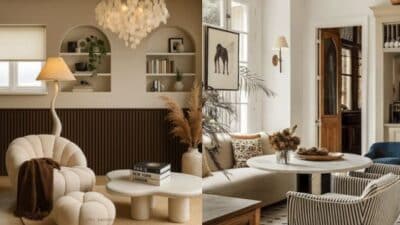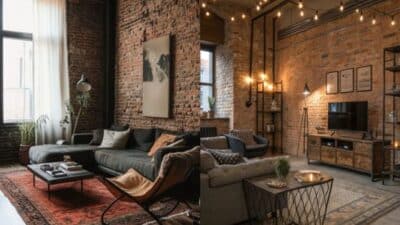Designing a laundry room is about balancing functionality with style to make a space that truly works for your daily needs. Whether you have a small corner or a spacious utility room, efficient layouts and smart storage solutions can significantly improve how you manage laundry tasks. A well-designed laundry room saves you time and effort while creating an organized, pleasant environment to work in.
Incorporating practical features such as built-in cabinets, countertop folding areas, and clever organization tools helps keep everything within reach. Paying attention to lighting, wall treatments, and decor can transform what is often a utilitarian space into a more inviting part of your home. Your laundry room can reflect both your personal taste and your household’s specific demands.
By focusing on smart use of space and thoughtful design choices, you’ll enhance both the convenience and appeal of your laundry room. This post will guide you through ideas that maximize efficiency without sacrificing aesthetics, ensuring your laundry routine becomes smoother and even enjoyable.
Key Takeways
- Efficient layouts and storage improve laundry room functionality.
- Practical features and organization tools streamline tasks.
- Style elements can make the space more inviting and personal.
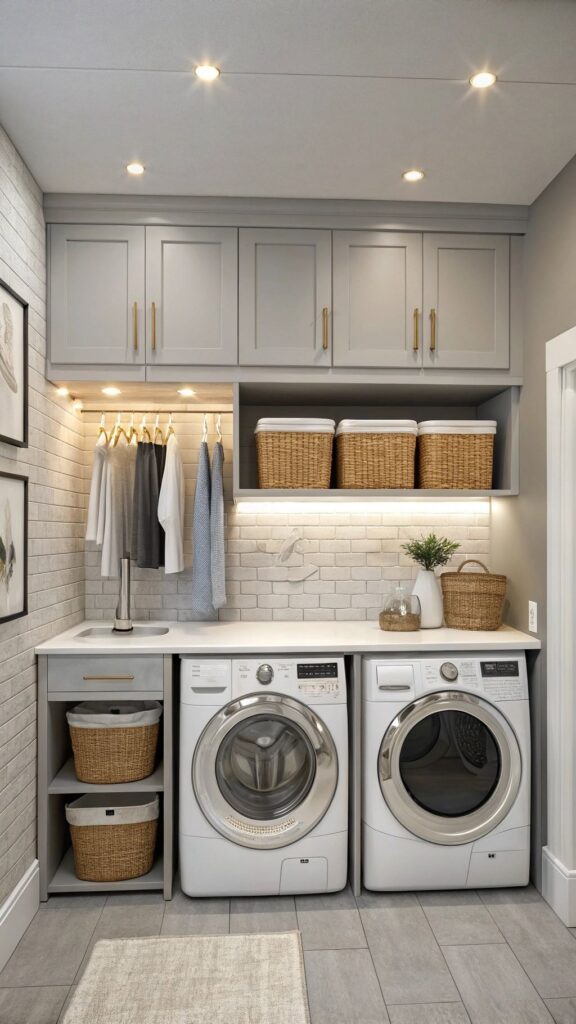
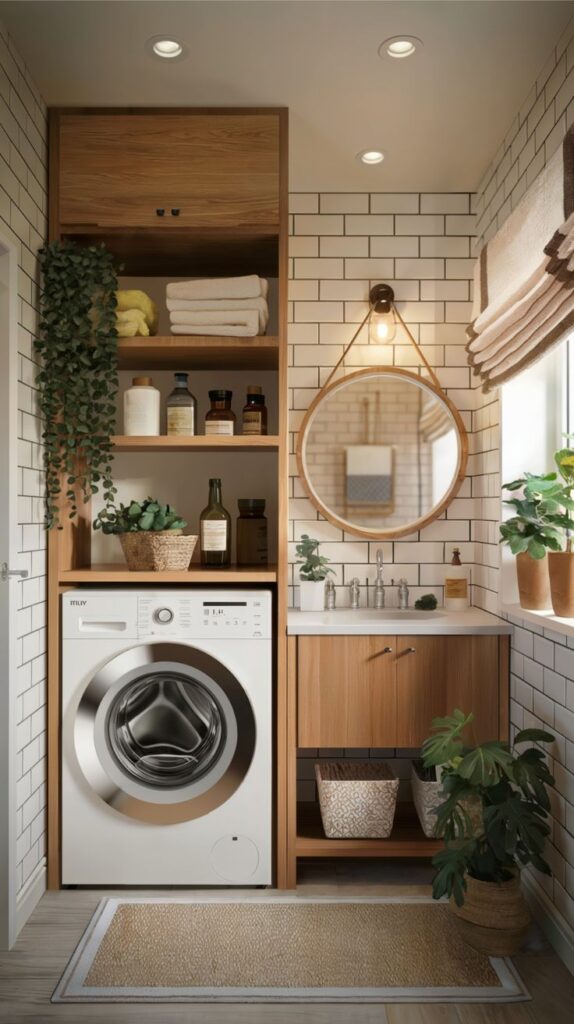
Essentials of Laundry Room Design
Creating a functional laundry room requires careful attention to the choice of appliances, layout, and practical features like utility sinks. These elements together improve efficiency and make your laundry tasks more manageable.
Choosing the Right Washer and Dryer
Selecting the right washer and dryer is crucial for your laundry room design. Front-loading washers and dryers offer better energy efficiency and typically use less water than top loaders. They also provide a sleek look and can be stacked to save space in smaller rooms.
Consider the size and capacity of the machines based on your household’s laundry needs. A larger capacity is helpful if you have many family members or wash bulky items frequently. Look for models with advanced settings for different fabric types to protect your clothes.
Energy-efficient models with high spin speeds reduce drying time and save energy. Noise level is another factor; quieter machines improve comfort if your laundry room is near living areas.
Optimizing Laundry Room Layout
An optimized layout enhances workflow and storage in your laundry room. Place the washer and dryer side-by-side or stacked, depending on your space constraints. Stacking is ideal for small rooms, while side-by-side allows for a folding area on top or beside the machines.
Plan for accessible storage with open shelves or closed cabinets to keep detergents and cleaning supplies organized. Consider including a countertop for folding clothes and sorting laundry.
Ensure ample lighting and proper ventilation to prevent moisture build-up. Maintaining a clear path between appliances, storage, and sinks makes tasks smoother.
| Key layout features | Recommendation |
|---|---|
| Washer/dryer arrangement | Side-by-side or stacked |
| Storage | Open shelving or cabinets |
| Workspace | Folding countertop near machines |
| Lighting and ventilation | Bright lighting and vent fan |
Incorporating Utility Sinks
Including a utility sink adds significant convenience to your laundry room design. It provides a dedicated space for hand-washing delicate items, soaking stained clothes, or cleaning up after household tasks.
Choose a deep, durable sink made from materials like stainless steel or resin to handle heavy use. Placement should be near your washer to streamline the washing process.
Adding a faucet with a pull-out spray head increases versatility. Ensure there is counter space around the sink for treating stains or storing cleaning tools.
Utility sinks can also serve multiple roles beyond laundry, making them a practical addition that optimizes your room’s functionality.
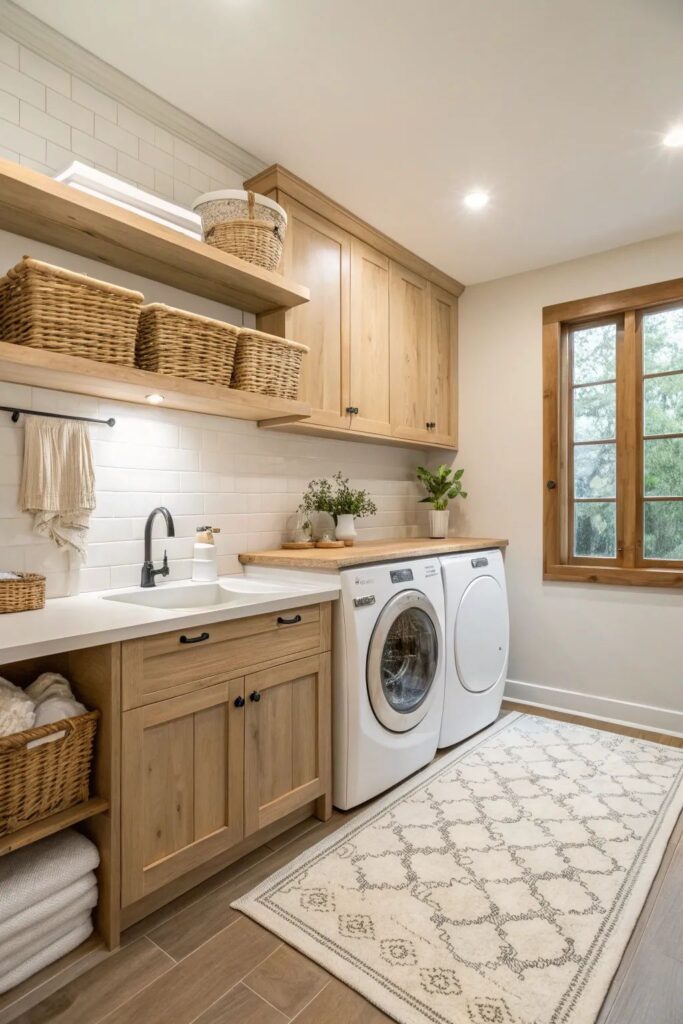
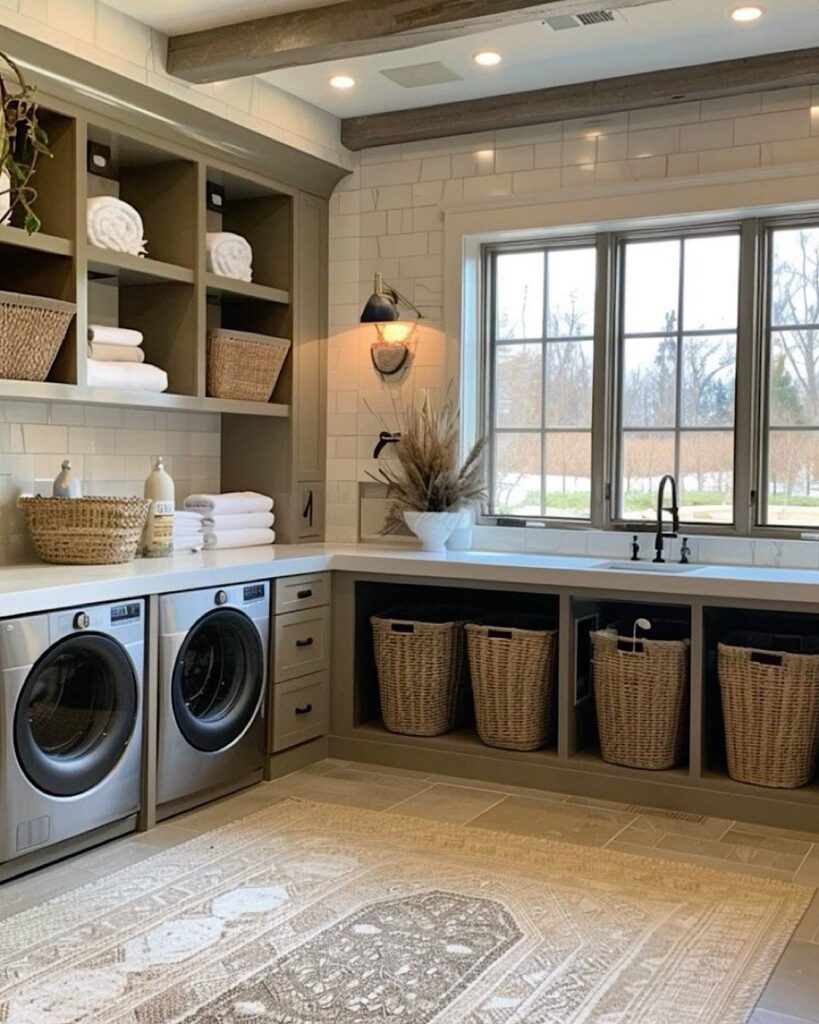
Smart Storage Solutions
Efficient use of space and organized storage are essential for a functional laundry room. You can optimize your laundry area by combining open shelves, custom cabinetry, upper cabinets, and wood countertops to keep everything accessible and neat.
Open Shelving Strategies
Open shelving allows you to store frequently used items like laundry baskets, detergents, and cleaning supplies within easy reach. Position shelves at eye level or slightly above to maximize convenience without cluttering your workspace.
Consider grouping items in clear bins or labeled baskets to maintain a tidy appearance. Open shelves are especially useful for displaying attractive containers or essential items you need quickly, reducing the need to open and close doors repeatedly.
Use sturdy materials that can support the weight of laundry products and baskets. You can also mix open shelving with hooks or pegboards underneath for added flexibility in hanging smaller items or tools.
Custom Cabinetry Features
Custom cabinetry lets you tailor storage to your specific needs, creating designated spaces for everything from detergents to ironing boards. You can incorporate pull-out shelves for easier access to heavy or awkward items.
Design cabinets with adjustable shelves to adapt to different laundry supplies or bulky cleaning tools. Soft-close doors and drawers contribute to quieter operation, making your laundry routine less disruptive.
Integrate vertical dividers inside cabinets for folding boards or drying racks. This approach keeps items organized and prevents clutter from accumulating in hidden spaces.
Upper Cabinets for Organization
Upper cabinets maximize vertical wall space, making them ideal for storing less frequently used items like specialty detergents and extra laundry baskets. Opt for cabinets that reach the ceiling to take full advantage of height.
Use opaque doors to conceal clutter and maintain a clean look. If you prefer visibility, choose cabinets with glass-front doors, but keep interiors orderly to avoid a messy appearance.
You can install under-cabinet lighting to brighten the workspace below, improving visibility when sorting or folding clothes. Upper cabinets also help keep hazardous cleaning products out of children’s reach.
Wood Countertop Integration
A wood countertop adds warmth to your laundry room and creates a durable surface for folding clothes or sorting laundry baskets. Choose hardwood or treated wood to withstand moisture and resist stains.
Size the countertop to cover your washer and dryer or to create a standalone folding station. Incorporate a backsplash for easy cleaning and protection from detergent splashes.
Wood counters complement both modern and traditional designs, pairing well with custom cabinetry and open shelves. Regular sealing and maintenance keep the surface functional and attractive over time.
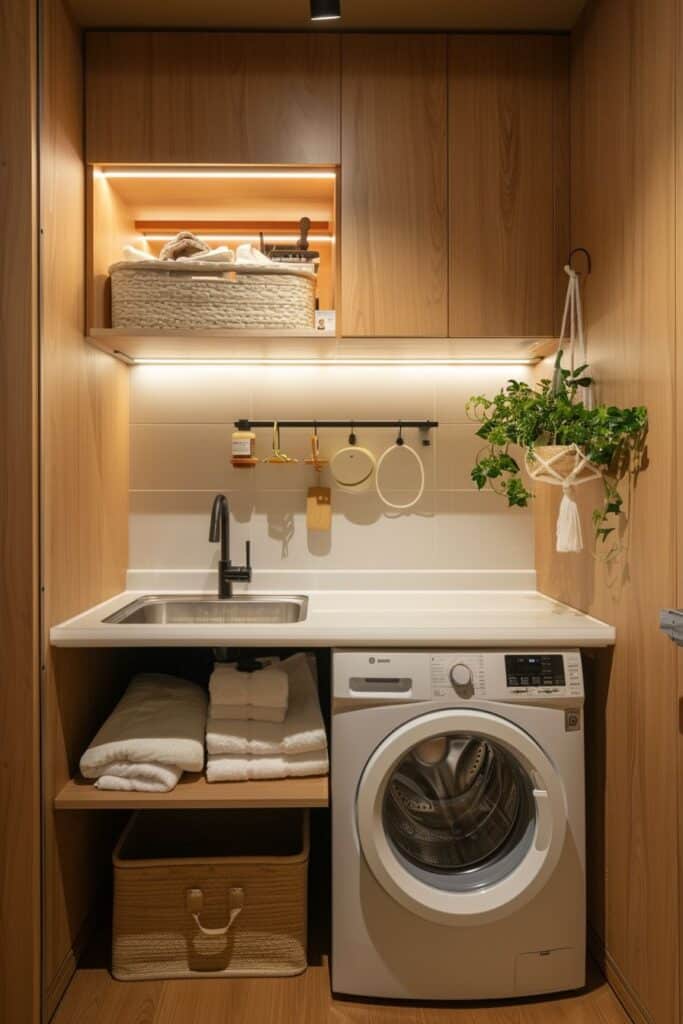
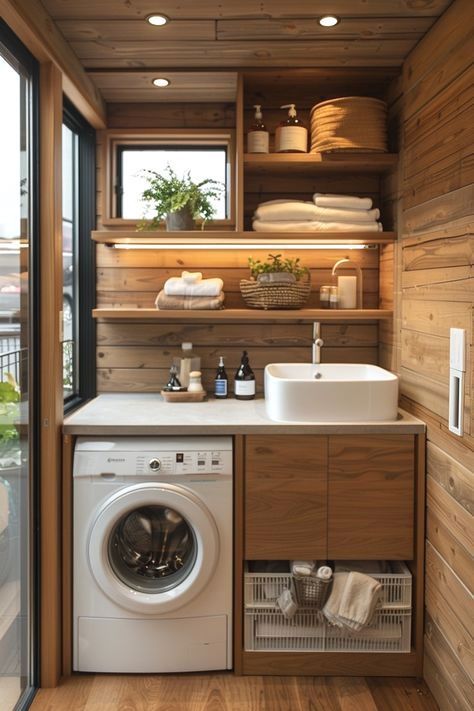
Small Laundry Room Design
Designing a small laundry room requires careful organization and smart choices to maximize every inch. Efficient layouts, suitable appliances, and practical storage options will help you create a space that works well without feeling cramped.
Maximizing Vertical Space
Use wall-mounted cabinets or open shelves to free up floor space. Storing detergents, cleaning supplies, and folded clothes above your washer and dryer keeps essentials within reach without cluttering counters.
Hooks and pegboards can hold items like ironing boards or laundry bags vertically. Consider tall, slim shelving units for storing baskets or bulkier items without reducing walkable space.
Adding a fold-down drying rack or ironing surface on the wall provides extra function while remaining unobtrusive. Vertical racks can also be installed in narrow spaces between appliances and walls.
Laundry Closet Ideas
If your laundry room is a closet, focus on compact, organized storage. Use stackable washer and dryer units to conserve space and free up floor area for additional shelving or cabinetry.
Install sliding or bi-fold doors to prevent door swing from taking up room. Incorporate pull-out hampers or baskets inside the closet to keep dirty laundry contained and easy to access.
Consider installing adjustable shelves or cubbies above your machines for storing supplies. Adding proper lighting inside the closet improves visibility and workflow in tight spaces.
Compact Appliance Selection
Choose stackable or slim-profile washers and dryers designed specifically for small spaces. These models often have smaller footprints but still offer efficient wash and dry cycles.
Front-loading machines allow for countertop space above when stacked or placed side-by-side. This surface can double as a folding or sorting area.
Look for energy-efficient appliances that save on water and electricity. Some compact units include smart features for easier control and maintenance, helping you optimize usability within limited space.
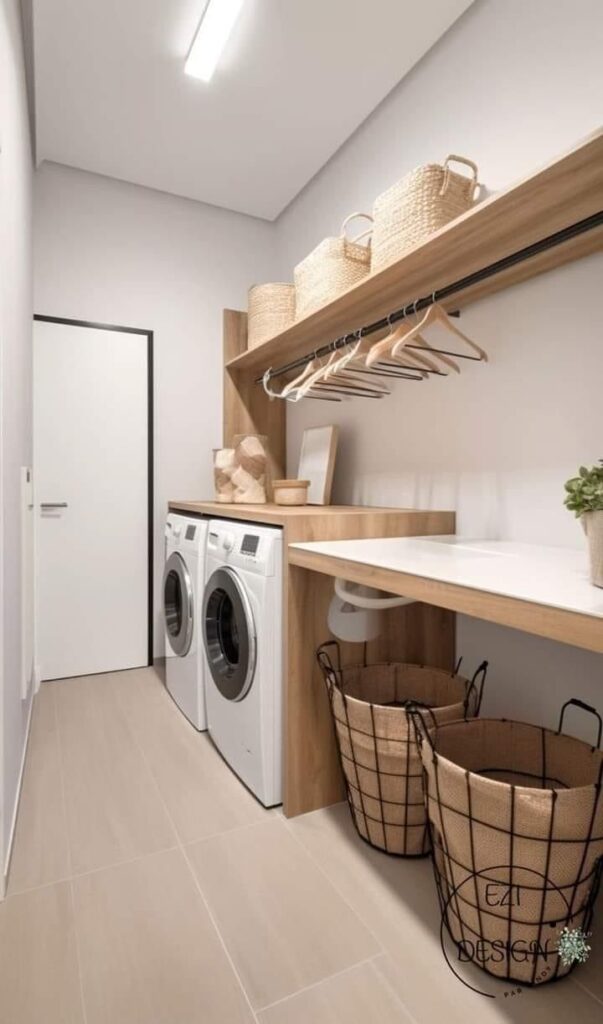
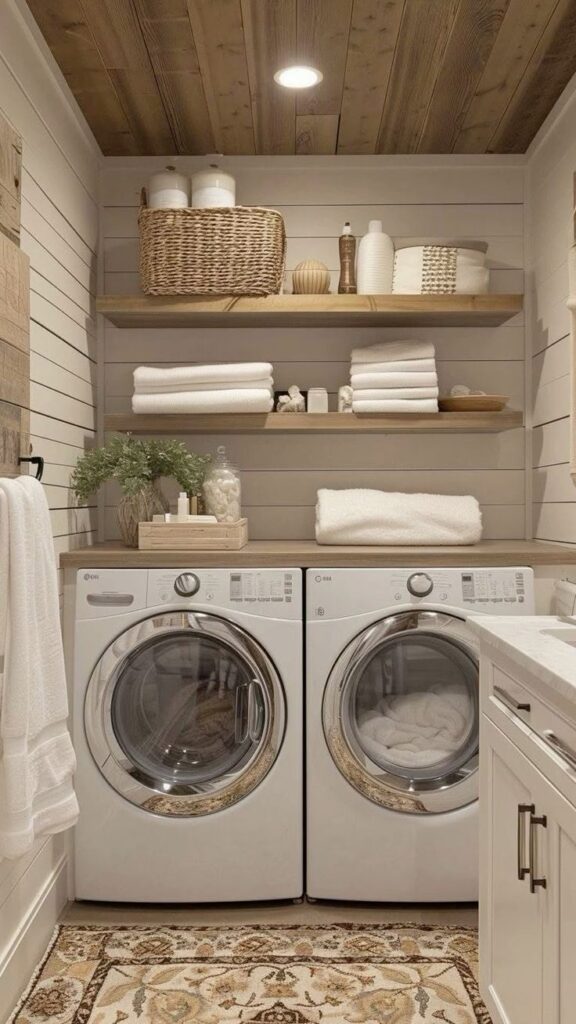
Functional Features and Accessories
Incorporating functional features into your laundry room can improve efficiency and save space. Thoughtful accessories help you manage tasks smoothly while maximizing available room and maintaining a clean look.
Drying Rack Installation
A drying rack is essential for items that can’t go in the dryer. Consider wall-mounted or foldable racks that save floor space but offer ample drying area. Installing a drying rack near a window or a vent can speed up drying time.
Choose racks made from rust-resistant materials like stainless steel or coated metal to ensure durability. Adjustable or retractable designs let you use the rack only when needed, keeping your laundry room clutter-free. Placement is key—mount it at a height that is comfortable for hanging without bending excessively.
Ironing Board Solutions
An ironing board integrated into your space can simplify your laundry routine. Wall-mounted or fold-down ironing boards offer convenience without occupying permanent floor space. Position it near an outlet for easy use of your iron.
Consider an ironing board with built-in storage compartments or shelves for your ironing essentials. If you have limited space, a pull-out board from cabinetry or a sliding panel can be practical and discreet. Opt for heat-resistant materials and a sturdy frame to ensure safety during use.
Practical Barn Door Uses
Barn doors can serve as effective space-savers in your laundry room. Unlike traditional swinging doors, barn doors slide along a track, freeing up room around entrances and exits. This is particularly useful in narrow spaces or where full door clearance is limited.
You can select barn doors made from durable wood or metal that complement your design style. They can also serve a dual purpose, such as concealing shelving or laundry appliances when not in use. Make sure the door track and hardware are securely installed to handle frequent use.
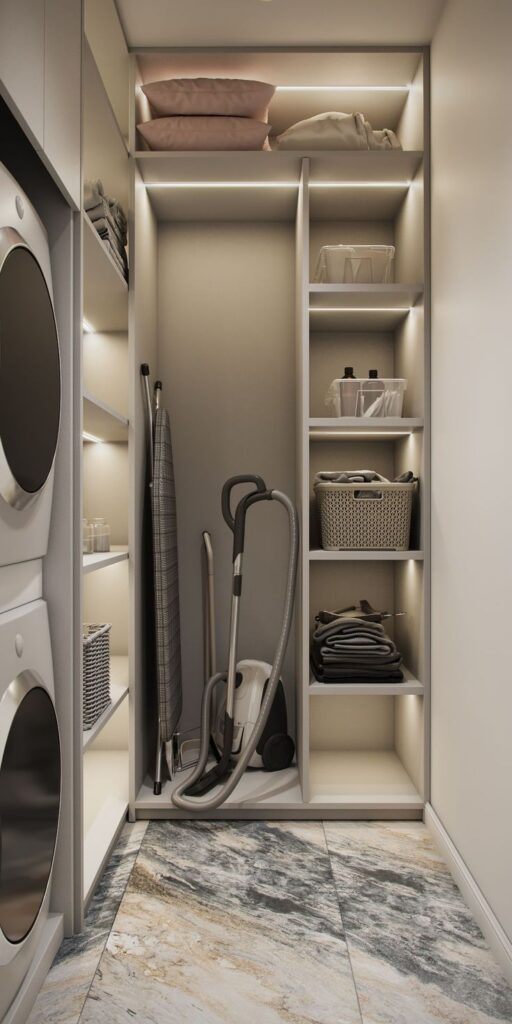
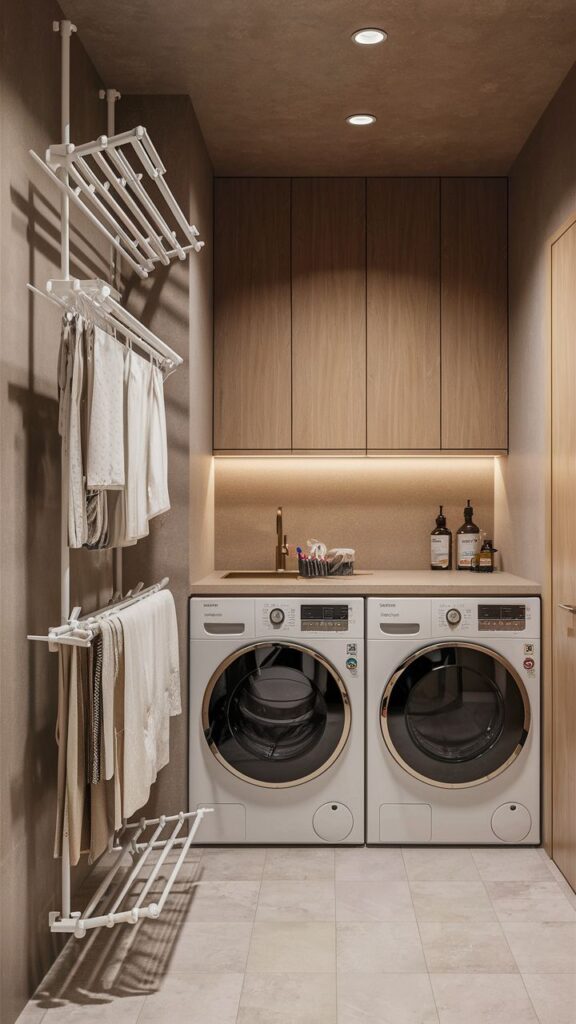
Style and Aesthetics
Your laundry room’s design should combine both function and visual appeal. Choosing the right style, materials, and lighting can make the space inviting and practical. Thoughtful details elevate the room and complement the rest of your home.
Farmhouse Laundry Influence
The farmhouse style adds warmth and character to your laundry room. Incorporate a farmhouse sink for a sturdy, practical feature that also serves as a focal point. These sinks provide deep basins ideal for soaking and hand-washing, merging utility with classic design.
Wood accents and vintage-inspired fixtures help complete the look. Think distressed wooden shelves or cabinetry alongside modern appliances. Earth tones, simple hardware, and open shelving contribute to the inviting, lived-in feel typical of farmhouse laundry rooms.
Keeping your space tidy is part of the farmhouse charm. An organized laundry room with designated baskets, hooks, and storage avoids clutter and maintains the room’s relaxed, functional nature.
Color and Material Choices
Selecting colors and materials impacts both atmosphere and upkeep. Neutral palettes like soft creams, muted grays, or navy blues create a calm, clean environment. These tones pair well with natural textures like wood, metal, or stone.
Durability matters in high-use areas. Choose water-resistant surfaces such as quartz or tile countertops and easy-to-clean backsplashes. Cabinets in matte or satin finishes reduce glare and hide fingerprints better than glossy surfaces.
Add visual interest by mixing materials. For example, combine a smooth quartz countertop with textured wooden cabinets. Contrasting finishes help break monotony while retaining a cohesive look.
Lighting and Finishing Touches
Proper lighting enhances functionality and mood. Layer your lighting with overhead fixtures, task lights near workspaces, and accent lights under cabinets. Bright, even illumination helps you spot stains and sort laundry efficiently.
Use natural light if possible. Windows or skylights improve the room’s feel and reduce dependence on artificial light. If natural light is limited, choose bright white bulbs to replicate daylight tones.
Finishing touches like patterned wallpaper, stylish hooks, and decorative rugs add personality. These elements make the laundry room feel less utilitarian and more integrated into your home’s style. Keep practicality in mind to avoid items that gather dust or impede movement.
- 0shares
- Facebook0
- Pinterest0
- Twitter0


